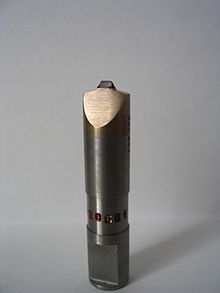Conditioning (grinding)
Conditioning describes the preparation of grinding wheels before the first machining or after they have become unusable due to wear . Conditioning is divided into dressing and cleaning. The dressing itself is divided into profiling and sharpening. When profiling, the grinding wheel is given a defined shape, and when sharpening, individual grains of the wheel are broken, thereby sharpening them. Profiling therefore relates to the shape of the entire grinding wheel, while sharpening relates to the microstructure of the individual grains.
Purpose of dressing
With the dressing, an exact concentricity and a correct geometric shape of the grinding wheel is achieved. In addition, dressing is used to profile or calibrate a grinding wheel. It also has the purpose of breaking out impurities and the dulled grain layer from the grinding wheel and thus exposing sharp grains. This reduces the heat generated during the grinding process.
A basic distinction must be made between shaping, sharpening and cleaning a grinding wheel. Since grinding wheels made of conventional abrasives such as corundum or silicon carbide are sharpened at the same time as they are shaped, this is generally referred to as dressing. The situation is different with grinding wheels made of boron nitride and diamond with a synthetic resin or metal bond. Here, the binding agent around the abrasive grains must be removed after molding.
Tools
For example, single- grain diamonds , multi-grain diamonds or diamond -set dressing rollers (forming rollers) are used as dressing tools . Dressing must be carried out under constant cooling with cooling lubricant , as diamonds are very sensitive to heat. In the best case scenario, the tools are arranged on the machine table, since the highest accuracy is achieved here and additional axes for controlling the tool are not required. Diamond profile rollers are also used in mass production. The high costs of these tools are only amortized with the number of pieces that arise there. The steel crushing roller is also worth mentioning as a special tool, with which profiles are rolled into the grinding wheels without relative speed.
Dressing process
Single-grain diamonds are guided along the grinding wheel during dressing and thereby break the top grain layer out of the grinding wheel. The diamond is clamped very briefly and inclined by 3 ° to 10 ° to the infeed and feed direction. The delivery amount is usually between 0.01 and 0.04 mm. If the diamond tip flattens out over time, the single-grain diamond is rotated 90 ° in the diamond holder to extend the life of the diamond. The dressing process usually takes place at certain intervals while the grinding wheel is not in contact. However, newer methods are also established on the market in which the grinding wheel is dressed at certain intervals ( in process dressing ) or also continuously ( continuous dressing ) during the grinding process .


